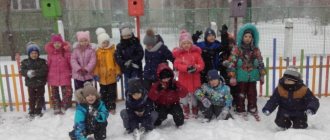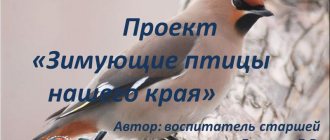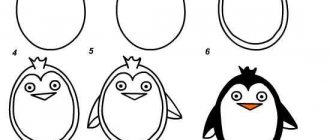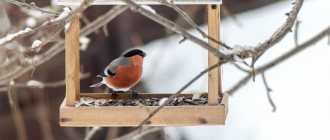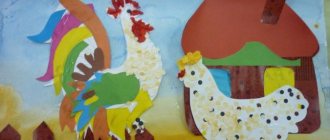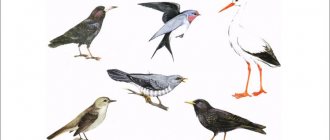Project in kindergarten in the senior group. Wintering birds
Project “Wintering birds of our region”
“Nature is the only book, every page is full of deep content” I.V. Goethe 1. Brief abstract of the project: Preschool childhood is a crucial period of human life: the foundations of a correct attitude towards the surrounding world (nature) are laid , things, people), value orientation in it. Fostering love and respect for the native land and nature is the most important component of moral education. To raise a good citizen who wants to protect and protect nature, you need to know it. Forming an understanding that man is part of nature, he must preserve, protect and defend it, that everything in nature is interconnected. Developing the ability to behave correctly in nature and protect it. 2. Project type: Educational, creative, short-term. Implementation time: 2 weeks. Project participants: children of the senior group of kindergarten, teachers. Venue: group, kindergarten area. 3. Relevance of the project: In modern conditions, the problem of moral, labor and environmental education of preschool children becomes particularly acute and relevant. It is during preschool childhood that the formation of human personality occurs. Therefore, it is very important to awaken in children an interest in living nature, to cultivate a love for it, to teach them to protect the world around them and take care of it. The theme of the project “Birds in Winter” was not chosen by chance. After all, it is birds that surround us all year round, bringing benefits and joy to people. During the cold season, there is significantly less available food, but the need for it increases. Sometimes natural food becomes practically unavailable, so many birds cannot survive the winter and die. And we, teachers, together with parents, must teach children to see this, expanding their understanding of wintering birds, their habits and way of life, and create conditions for the child to communicate with the natural world. 4. Statement of the problem Insufficient understanding of children about wintering birds. Children do not have enough understanding of the lifestyle, habits, nutrition and homes of wintering birds, and how they feed in the winter. 5. Goals and objectives of the project: To cultivate a careful, caring, responsible attitude towards wintering birds, to form ecological knowledge about them. Project objectives: for children:
to expand children’s knowledge about wintering birds, to form a caring, responsible attitude towards the natural world, basic environmental knowledge;
cultivate a desire to help birds in difficult winter conditions; learn to reflect your attitude to the natural world in productive activities. for parents:
to create activity and interest in the educational process;
involve in the manufacture of bird feeders and their feeding; teach parents to show their children by personal example how to treat nature with care, protect and care for it. for teachers:
to replenish the subject-development environment on the topic of the project, to introduce effective methods and techniques into the educational process to expand children’s knowledge about wintering birds.
6. Expected result: for children:
have an idea of wintering birds;
understand that it is easier for birds to endure harsh winters when people take care of them; know how to make a feeding trough together with their parents; they know how and what food to feed the birds; are able to observe and analyze their own activities; show care and responsibility towards the environment. for parents:
show great interest in the life of children in kindergarten;
assist the child in performing creative work; active project participants. for teachers:
closer cooperation with the families of pupils.
7. Activities for project implementation: Stage 1 Preparatory Setting project goals, determining knowledge, relevance of the project; selection of methodological literature, visual and didactic material, fiction, photographs; organization of a development environment. Conversations with parents about the need for their participation in the project, about a serious attitude towards the educational process in the preschool educational institution. Stage 2 Practical Cognitive development:
1. GCD “Wintering birds” 2. Conversation “Wintering and migratory birds” 3. Conversation “What does a bird need more, warmth or food?”
4. Conversation “Why does the feeder need a roof?” 5. Didactic games: “Guess by description” Purpose: to teach how to write a descriptive story about the proposed bird without showing it. “Counting Birds” Purpose: to strengthen children’s ability to coordinate numerals with nouns. “Call it affectionately” Purpose: to practice word formation (tit-titmouse, sparrow-sparrow). “The fourth odd one” Purpose: to consolidate children’s knowledge about wintering birds and their appearance. Physical development
1. Morning exercises.
2. Outdoor games: “Crows”, “Birds sitting in nests”, “Sparrows and a car”, “Owl”, “Sparrows and a dog”, “Wintering and migratory birds” (with a ball. 3. Finger gymnastics: “How many birds flew to our feeder", "Come, birds", "Feeder", "Magpie", "The birds flew in", "Woodpecker". 4. Rhythmic exercise: "Bullfinches" Artistic and aesthetic development:
Drawing - "Bullfinch on a branch" Construction from paper “Titmouse” Modeling - “Sparrow from a cone” Research activity - examination and examination of feathers; - name parts of the body; - coloring; - what they eat; - Life Lifestyle: Conversation “What to feed birds?” “How to help birds;” Reading fiction literature: V. Sukhomlinsky “How the titmouse wakes me up”, O. Grigorieva “Titmouse”, L. Voronkova “Bird feeders”, V. Zvyagina “Sparrow”, T. Evdoshenko “Take care of the birds”, Y. Nikonov “Winter guests”, M. Gorky “Sparrow.”
Speech development
1. Examination of the poster “Wintering Birds.” 2. Examination of illustrations, photographs on the topic: “Birds,” “Birds at the feeder.”
3. Reading and discussion of proverbs and sayings about wintering birds. 4. Memorizing A. Yashin’s poem “Feed the birds in winter” Activities on a walk Tour of the kindergarten grounds. Bird watching. Labor - cleaning up broken branches on the site. Joint work with parents Fix the name of wintering birds, draw a poster of birds in winter Advise to go on an excursion to the forest or park. Work with a speech therapist on this topic. 3. Final stage Design of the exhibition “Wintering Birds”. View the summary presentation: “Birds in winter.” Hanging feeders on the site. Design of the laptop “Wintering Birds” As a result of the work done, the children learned: What types of birds remain to spend the winter in our area, and which ones fly to us for the winter; How to distinguish birds by color; What food do birds prefer? The following conclusions were made: Birds become noticeable and more active as the weather warms up; the brighter the sun shines, the more birds there are on the street, the more active they are; Birds do not fly on windy days; As food, pigeons and sparrows prefer seeds, and tits prefer lard; Sparrows, pigeons (They rarely appear, there are more of them in the city), waxwings fly in flocks, tits in 3-4 groups, crows - alone. 5 species of birds visited the feeder; During the project, the birds have become accustomed to receiving food, so feeding must be continued.
We recommend watching:
Summary of organizing a joint educational activity with children of the younger group. Birds in winter Summary of GCD in the middle group. Wintering birds Poems for children 4-6 years old on the topic: Birds in winter Summary of educational activities in the senior group: Birds in winter
Similar articles:
Winter holiday in grades 1-2. Scenario “Caring for Birds in Winter”
Conversation in kindergarten on the topic: “Wintering birds” in the preparatory group
A story about a pigeon, grades 1-2. The world
A story about a canary for children, grades 1-2
Pedagogical project “Animals and birds of our region”
Type of project: creative and research.
The participants are children.
Scale – 2 months.
Conditions - material:
Photographs and illustrations of animals, birds; footprints; food chains, interesting facts from the life of birds and animals; mnemonic diagrams; tales of the peoples of the North; diagram “How does a forester help wild animals?”; stories by G. Snegirev; feather; didactic games; stories about the holidays of the peoples of the North; word games; Nenets patterns; counting rhymes; riddles, map, globe.
Explanatory note
Relevance:
Many Russians prefer to spend their holidays in other countries. Children there gain knowledge and ideas about flora and fauna. Unfortunately, these countries are of more interest to children than their native places. I believe that children should first of all know their native land, since children’s acquaintance with their native land, its national, natural, and geographical features forms a love for their small homeland and concern for its well-being.
With the introduction of the Law of the Russian Federation “On Education”, it became a priority to introduce preschool children to the national and regional cultures and heritage of the region, since you cannot recognize the world without knowing your land.
Problem:
I conducted conversations and diagnostics of children, which showed that 75% of children find it difficult to answer which representatives of the fauna live in our region (besides the well-known ones - wolf, hare, fox, etc.), how they adapted to life in harsh conditions. The children’s knowledge turned out to be superficial, so I decided that the children’s knowledge needed to be expanded and deepened.
Target:
Create conditions for children aged 5-6 years to become familiar with the fauna of their native land (Yamalo-Nenets Autonomous Okrug).
Tasks:
1) Enrich the local history knowledge of children 5-6 years old;
2) To stimulate in preschoolers the experience of active knowledge of phenomena occurring in nature;
3) Induce in children a caring and creative attitude towards nature;
4) Promote cooperation between children and adults during the project.
Hypothesis – education of local history culture in preschool children will be effective if productive activities, didactic and verbal games, stories, fairy tales, poems, research activities (experiments), creation of problem situations, and involvement of parents are used in the work. This will provide an opportunity to expand children’s knowledge about the life of animals in the Yamal-Nenets Autonomous Okrug and to form a sustainable interest in wildlife.
Expected Result:
- Children receive interesting and useful information that will expand and enrich their knowledge;
- Enriching children's vocabulary;
- Children will learn to take care of nature so that small representatives of the fauna do not disappear;
- Children's knowledge will rise to a higher level (70% above average, and 30% high).
Annotation:
The implementation of the project will contribute to:
1) Expanding and deepening the knowledge of children and adults about the fauna of our region.
2) Emotional unity of children and adults through games, creating a project environment.
3) Increasing interest in the nature of the native land.
4) Expanding knowledge about holidays, fairy tales, rhymes of the peoples of the North, respect for their culture.
5) Education of moral qualities: the desire of representatives to care for, protect, and preserve representatives of the fauna of the Yamal-Nenets Autonomous Okrug.
Project implementation
At the beginning of the project, the guys and I looked at the animals and birds of our region. We noted the appearance and name. Further schemes of wild and domestic birds and animals were proposed. The children found similarities and differences between them, and did not forget to talk about housing, food, and movement.
Reinforced knowledge in didactic games “Whose house?”; "Make a Family"; “Whose mother?”; “Whose house?”; “Who gives the voice?”; “Who moves how?”;
The game was played with a ball or a toy. It is unusual in that you cannot simply suggest a word - you need to present the hint in such a way that your friend can guess the answer himself.
The children liked and had doubts about the game “Signs of a Living Organism.” The guys could not imagine that animals take pills and stones grow. Therefore, we add a few fables to our conversations, which develops children’s thinking, sense of humor and increases the interest of the activity. We also purchased and grew minerals. The children saw a miracle! Beautiful, intricately shaped stones grew from the dry matter. How can you say that they are not alive!
Then we looked for interesting facts about animals and birds of the Yamal-Nenets Autonomous Okrug with the children and parents.
They caused a lot of surprise and admiration. It turned out that pika hamsters steal hay from each other, that an eagle owl can eat a hedgehog with spines; a woodpecker sleeps clinging to a hollow with its paw; the walrus sleeps standing in the water; The tit used to be given a safe conduct - whoever caught it was punished; The wolf and the squirrel know how to swim, the ermine hunts at night, and the chipmunk, if it hears that a girl (female) is calling him, drops everything and runs to her, the dipper dives under water even in winter.
The guys remembered that all waterfowl dive under water, but do not get wet. We decided to check this and conducted an experiment with a feather. After the experience, we think, “if people had clothes that didn’t get wet, would that be good or bad?”
Children liked and remembered interesting facts from the life of animals and birds, and therefore they gladly made up riddles for their friends and parents.
So that parents could expand their knowledge on this issue, a card index “Fauna of the Yamal-Nenets Autonomous Okrug” was created.
In the group, the guys and I organized an exhibition of books: S.V. Sakharnov, G. Snegirev, R. Kipling, I. Istomin, and other writers. These works introduced children to the habits and behavioral characteristics of animals in our region. The fairy tales of R. Kipling and I. Istomin aroused great interest and discussion - “does this really happen?” This will be useful for inventing fairy tales in the future.
Then the guys and I found our country on the map and globe. They noted how big it was. And our Yamal is not at all great. The photographs showed it to us both above and below. We have taiga and tundra, many lakes and swamps.
The didactic game “Natural Areas” helped determine the habitat of the animals. In it, the children made up chains of inhabitants of the tundra, taiga, lakes, and ice zones. By the way, there was also a Nenets fairy tale about bears. We changed their habitat and imagined how they would live in different conditions.
We remember that learning to read and write is always useful - we identified the first letter in the names of animals and birds. Then they compiled a letter depot.
— During the conversation “Our Land,” the guys had a question: “How do animals survive in the North?” It’s cold in winter, but they don’t have fur coats or an apartment. To answer the question, we went into the winter forest. We went on a reindeer sled (hoops or jump ropes). We arrived and saw a lot of tracks. We immediately recognized the tracks of a bear and a hedgehog.
We wondered - could they leave traces in winter? The guys were surprised by the hare's tracks. They were everywhere.
Using a mnemonic table, the guys found safe housing for the hare and moose, away from predators, closer to the squirrel and sleeping bear.
In winter, not only wool, but also snow warms animals. The guys had doubts - how does cold snow warm you? So we did an experiment with water bottles. The children understood why birds and animals sleep under the snow.
Many guys expressed the opinion that predators should be evicted from the animals to another place, but it turned out that this would also be wrong. Food chains have proven this. In nature, everything is interconnected. The children told their parents about this and gave them drawings of food chains.
People help animals and birds survive the cold winter. Conversation “Who is a forester?” I told the children what they can and should do in the forest, and what they shouldn’t.
It is no secret that the result of people's rash actions can result in natural resources becoming unsuitable for life. We remembered how to protect rivers and land. Fires cause a lot of damage to flora and fauna. The children were asked to put out the fire on the advice of K. Chukovsky from the poem “Confusion.”
The guys offered their options on how to put out the fire and save the animals.
The acquired knowledge was consolidated with the help of the didactic game “Rules of Behavior in Nature.” The children wanted to share their impressions with their parents and drew rules for them
Then the children learned about the book “The Red Book of the Yamal-Nenets Autonomous Okrug”, which animals and birds are included in it and why they need to be protected. With the help of parents, we selected illustrations depicting protected animals and birds of the Yamal-Nenets Autonomous Okrug and released a poster collage “They need to be saved”
Parents also consider it important to teach their children a caring, responsible attitude towards nature. They actively help birds and squirrels survive the harsh winter: they make feeders and bring food. This positive example will remain in the children’s memory for a long time.
Parents took part in the design of the exhibition “Our Arctic”; the exhibits of the exhibition were animals and birds made by children from plasticine, paper (origami), and natural materials.
The indigenous people, the Nenets, have lived on this land for many years. We decided to ask them (interview them) how they protect nature. Residents of the village of Kutopyugan told about this. The story was interesting and instructive.
The Nenets not only know how to protect nature, they hold holidays: “Bear Festival”; “Seeing off the swan”; "Day of the Raven"
The guys got acquainted with the holidays and played the Nenets game “Stop the deer!” And they made a broken appliqué “Raven”; "Swan".
Deer is a sacred animal among the Nenets; where it is, there is life. It is also included in the Red Book of the Yamal-Nenets Autonomous Okrug. The guys learned the characteristics of its body, and then painted the deer with beautiful patterns.
The entire life of the Nenets is spent in nature, so they themselves come up with riddles and rhymes about what they see. The boys and I learned Nenets rhymes about animals and birds. We learned to solve riddles.
The craftswomen of the peoples of the North came up with patterns, they also borrowed them from the flora and fauna of the Yamal-Nenets Autonomous Okrug. The guys and I looked at the patterns: “Hare Ears”; And "Fox's Elbow"; “Deer head” and decorated handbags with them. And they gave the bags to their parents.
At the end of the project, the guys and I turn to the adults:
- Let's take care of the nature of the Yamal-Nenets Autonomous Okrug together so that it is preserved not only in riddles, counting rhymes, patterns on a handbag and in real life!
Author: Tokhtieva Victoria Olegovna, teacher of the combined type MKDOU “Kindergarten “Buratino” in Nadym”, Yamal-Nenets Autonomous Okrug, Russia.
The article is published in the author's edition
Project in the middle group on the topic: “Wintering birds”
Project topic
: “Wintering birds.”
Project type:
cognitive and research.
Project type
: short-term
Participants:
teachers, middle school children, parents of students.
Requirements of the external environment: Now (in winter), birds, in search of food, have migrated closer to people. We just need to help our feathered friends. But how? To answer this question you need to know who to expect to visit? How to help birds survive the winter? What to feed the birds? In our difficult age, when environmental issues are more important than ever, the problem of environmental education of the younger generation is one of the most pressing. It is during the period of preschool childhood that the formation of the human personality and the formation of the beginnings of ecological culture take place.
Relevance:
to cultivate children's interest in birds, the desire to learn new facts about their life, to take care of them, to rejoice in the knowledge that by sharing crumbs, you can save birds from death in winter. Give children basic knowledge of what to feed birds in winter.
Problem:
insufficient understanding of children about wintering birds and their needs during the winter period.
Target:
expand and generalize children’s ideas about wintering birds through the organization of cognitive and productive activities.
Tasks:
- expand students’ knowledge about wintering birds;
-promote the development of children's creative and intellectual abilities;
-instill independence in productive and cognitive activities;
-attract the attention of children and parents to helping birds during difficult winter times;
-replenish the subject-development environment on the topic of the project.
Activities to solve problems:
Stage 1 – preparatory:
1. Determining the level of knowledge of children:
Conversation using illustrative material “What do you know about birds”;
D/i “Wintering Birds”; D/i “What birds don’t you see in winter?”
2. Selection of information on the project topic: “It’s difficult for birds to winter”
3. Conversations with parents on the topic of the project:
"Feed the birds in winter"
4. Decorating a book corner (selection of books about wintering birds)
Stage 2 – main:
1. Cognitive:
Looking at birds in pictures (Painting “Waxwings”, photographs: “Bullfinches on a branch”, “At a feeding trough”, “Sparrows”)
Presentation “We stayed for the winter”
Conversations (“Birds in winter”; “How do children and parents take care of birds in winter?”; “Do tits bring benefit or harm to humans in winter)
Bird watching during a walk (bird tracks in the snow; crow; magpie; bullfinches; titmouse; pigeons; waxwings).
FEMP (“Comparison of objects by number and height”; “Comparison of objects by size and quantity”; “More - less or equally”; “How many birds are on the feeder”)
